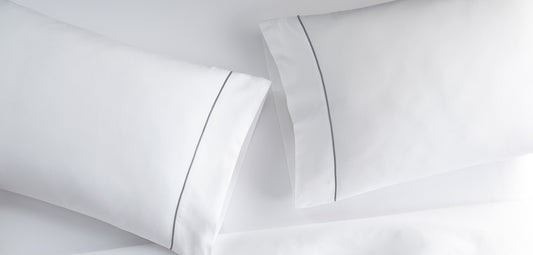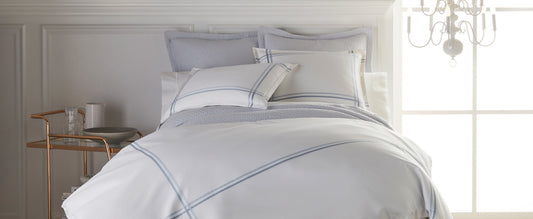If you’ve spent any time perusing our collection of luxury bedding, you’ve most likely run across the terms “pillow case” and “pillow sham.”
For those not well versed in the language of interior decorators, this can be somewhat confusing. You may find yourself wondering, what is a sham? Is it just another term for a pillow case? In fact, you may even find websites and blogs who say that pillow cases and pillow shams are the same thing. In truth, they’re similar, but not the same.
What is the Difference Between A Sham and a Pillow Case?
Simply put, a pillow case is used to keep your pillow clean as you sleep while a pillow sham is used to hide your pillows behind a more decorative façade.
But how can you tell which is which?
Typically pillow cases are open at one end, with no type of closure. They tend to be simpler, and therefore less decorative. They’re often made from the same fabric as the sheets they accompany. Better quality pillow cases may include decorative touches, typically along the open cuff. This may include embroidery, hemstitching, or coordinating fabrics used for the cuff.
Pillow shams, on the other hand, tend to open from the back, sometimes with a hidden closure, and other times with an overlapping length of fabric. They are typically bordered on three or, more commonly, four sides with a flat piece of fabric called a flange. The flange may be decorated with embroidery or other accents, or it can be plain. The pillow sham is typically designed to match the more decorative elements of bedding such as a coverlet or duvet cover, or it can be uniquely designed to add a pop of color, pull other colors from the room into the bedding ensemble, or otherwise stand out.
Shop Pillow Shams

Juliet Matelassé Sham

Lucia Matelassé Sham

Montauk Matelassé Sham
Can You Sleep On a Sham?
While technically yes, you can sleep on a pillow sham, and certainly some people do, that’s not really their purpose. In fact, many shams may be less comfortable to sleep on, either because they’re made from textured decorative fabrics, or because the flanges may be bulky and awkwardly bunch up as you sleep.
So what do you do with them when it’s time for bed? Some choose to place their shams behind their bed pillows as they sleep, adding a layering of padding between the sleeper’s head and the headboard of the bed. More commonly, shams can simply be removed from the bed entirely during the night, to help keep them clean and avoid soiling them with oils from skin or hair.
Styling with Shams
While there are many ways to style your bed pillows, a few standard arrangements are most common.
Stacked

This is probably the most simple arrangement, and one seen in many homes around the world. Start by laying your sleeping pillows flat against the mattress. Typically, the cuffs are pointed outward toward the edges of the bed. Then stack pillows with decorative shams on top of them. This creates a quick but pleasing arrangement. Some then choose to lean decorative accent pillows against the stack, but a more minimalist look does not require them.
Layered
One of our favorite arrangements, this allows you to display pillows of different sizes, fabrics, textures, and colors in an eye-catching and symmetrical way. Start by leaning your sleeping pillows against the headboard, again with the cuffs toward the edge of the bed. Leaning against those, display several Euro size pillows dressed in shams in a clean or overlapping row. Next, place two standard or king sized pillows, also in shams, in front. Finally, add decorative pillows such as boudoir, bolster, or neck roll sizes in front if desired. This look can easily be tailored to fit as many or as few decorative pillows as you like, for nearly infinite design possibilities!
Asymmetrical
This one makes for a less structured, more creative sense of style. The arrangement is similar to the layered option above, but using larger and/or smaller pillows on only one side of the bed or the other. This works best if all the pillows are similar in color and texture, with the possible exception of the smaller decorative throw pillows in the front.
Bed Sham FAQs
Q: How do shams differ from pillowcases?
A: The primary difference is in their purpose and design. Pillowcases are made for sleeping pillows, focusing on comfort and protection, with an open end for easy access. Shams, on the other hand, are decorative covers with back closures, often featuring embellishments, and are used to adorn pillows that serve a decorative role.
Q: What is a bed sham?
A: A bed sham is the same thing as a pillow sham. They are decorative pillow covers designed to enhance the appearance of your bed. Unlike standard pillowcases, which are primarily functional and open at one end, shams typically have a back closure and include decorative elements such as flanges, embroidery, or unique textures. They are used to cover pillows intended for display, giving your bedding a polished and cohesive look.
Q: How should bed shams be styled on a bed?
A: Bed shams can be styled in several ways to enhance the look of your bed. They are often placed in front of your sleeping pillows or layered behind for added depth. You can arrange them symmetrically or mix them with other decorative pillows to create a visually appealing and personalized bed arrangement.
Q: Is a bed sham for bed required?
A: No, a bed sham is not required. Its purpose is purely decorative, and whether to use one depends on your personal style and preferences. Bed shams can elevate the overall aesthetic of your bed by introducing different patterns, colors, and textures. However, if you prefer a simpler or more functional bedding arrangement, you can skip using shams.
Q: Are shams available in different sizes?
A: Yes, bed shams come in various sizes to match standard pillow dimensions. Common sizes include standard, queen, king, and Euro (European) shams, so you can choose the appropriate size based on your pillows and bed styling preferences.
Q: Can you sleep on pillows with shams?
A: While it is possible to sleep on pillows with shams, they are primarily designed for decorative purposes. Shams may have embellishments or textures that make them less comfortable for sleeping. Typically, sham-covered pillows are removed before bedtime.





































